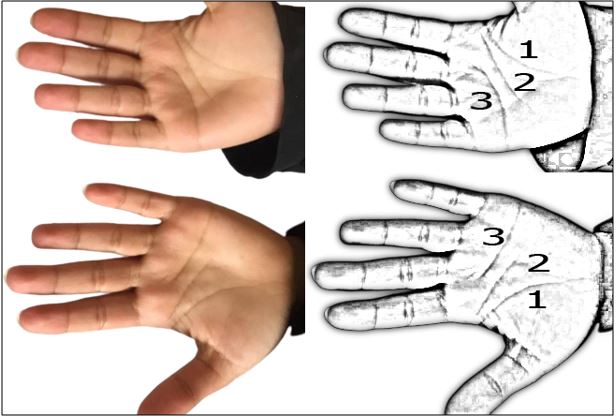Anatomical Variations in Palmar Creases and Their Correlation to The Intelligence Capacity of Libyan Medical and Dental Students of Omar Al-Mukhtar University.
Abstract
Background: For centuries, clinicians, anthropologists, and palmists have found the creases in the palm interesting. However, only in the last fifty years that research's started to examine the variations in these creases. Based on the three main palmar creases, thenar, proximal, and distal transverse creases, four patterns of palmar creases are identified; nonvariant, Sydney, Suwon, and simian. Previous studies of palmar creases revealed that familial components, race, sex, and age are factors that influence the expression of palmar crease patterns. Simian patterns of palmar creases are linked to various congenital diseases, some characterized by low level of intelligence.
Aim: This paper aims to investigate the variations in palmar crease patterns among medical and dental students of Omar Al-Mukhtar University and to study the range of intelligence capacity associated with each pattern.
Materials and methods: The study was conducted on 183 students. A paper-based IQ test was performed and photos were taken from both palms of all participants.
Results: Out of 183 participants, the nonvariant pattern of palmar creases was found in 92%, in which, 100 students have bilateral 2 points of origin palmar creases and 48 students have bilateral 3 points of origin palmar creases, whereas 18 participants have one palm of 2 points and the other palm of 3 points of origin. Unilateral simian was the dominant type in the aberrant palmar creases, followed by bilateral Sydney, then unilateral Sydney, and Suwon.
Conclusion: The students with unilateral simian have the highest average score of 47.166 followed by bilateral nonvariant and unilateral nonvariant. Students with unilateral Sydney have the lowest average score of 41.
Downloads
References
Mattison SM, Brunson EK, Holman DJ. Palmar Creases: Classification, Reliability and Relationships to Fetal Alcohol Spectrum Disorders (FASD). Coll Antropol. 2015;39(3):769-774.
Afework M. Prevalence of the Different Types of Palmar Creases Among Medical and Dental Students in Addis Ababa, Ethiopia. Ethiop J Health Sci. 2019;29(3):391-400. doi:10.4314/ejhs.v29i3.12
Brant AM, Haberstick BC, Corley RP, Wadsworth SJ, DeFries JC, Hewitt JK. The developmental etiology of high IQ. Behav Genet. 2009;39(4):393-405. doi:10.1007/s10519-009-9268-x
Alter M. Variation in palmar creases. Am J Dis Child. 1970;120(5):424-431. doi:10.1001/archpedi.1970.02100100088008
Wahl L, Dupont G, Tubbs RS. The simian crease: Relationship to various genetic disorders. Clin Anat. 2019;32(8):1042-1047. doi:10.1002/ca.23432
Rook, L. W. Biomarkers of mental illness and the human hand: A systematic review. The European Journal of Psychiatry, 2022;36(2):77-93.
Purvis-Smith SG, Menser MA. Dermatoglyphics in adults with congenital rubella. Lancet. 1968;2(7560):141-143. doi:10.1016/s0140-6736(68)90422-4
Kanazawa, S. Single Transverse Palmar Crease as a Potential Risk Factor for COVID-19. Infectious Diseases in Clinical Practice, 2023;31(3):1-5.
Lloreda-Garcia JM, Pina-Molina JM, Fernández-Fructuoso JR. Deep Palmar and Plantar Creases in Costello Syndrome. J Pediatr. 2018;201:292. doi:10.1016/j.jpeds.2018.05.045
Sharma, D., & Sharma, V. (2011). Prevalences of Simian, Sydney and Suwon creases and their association with each other, body sides, handedness, sex and anomalies/diseases/syndromes in a population of Central india. International Journal of Morphology 2011; 29 (3):1069-1075.
Vass, V. A. (1992). Standardization of Raven's Standard Progressive Matrices for Secondary school African pupils in the Grahamstown region. Rhodes University Grahamstown,
Albizu, C., Matlin, N., & Stanton, H. (1966). The successful retardate. San Juan: Division of Vocational Rehabilitation, Department of Education, San Juan, PR.
Park JS, Shin DS, Jung W, Chung MS. Improved analysis of palm creases. Anat Cell B, 2010;43 (2):169-177.
Alhaji MM, Timbuak J, Umana UE, Tanko M. Palm creases and handedness in Hausas of northern Nigeria: a crosssectional study. Asian J Biol and Med Sci, 2015;1(2): 6-13.

Copyright (c) 2023 Author (s). Published by Siddharth Health Research and Social Welfare Society

This work is licensed under a Creative Commons Attribution 4.0 International License.


 OAI - Open Archives Initiative
OAI - Open Archives Initiative


